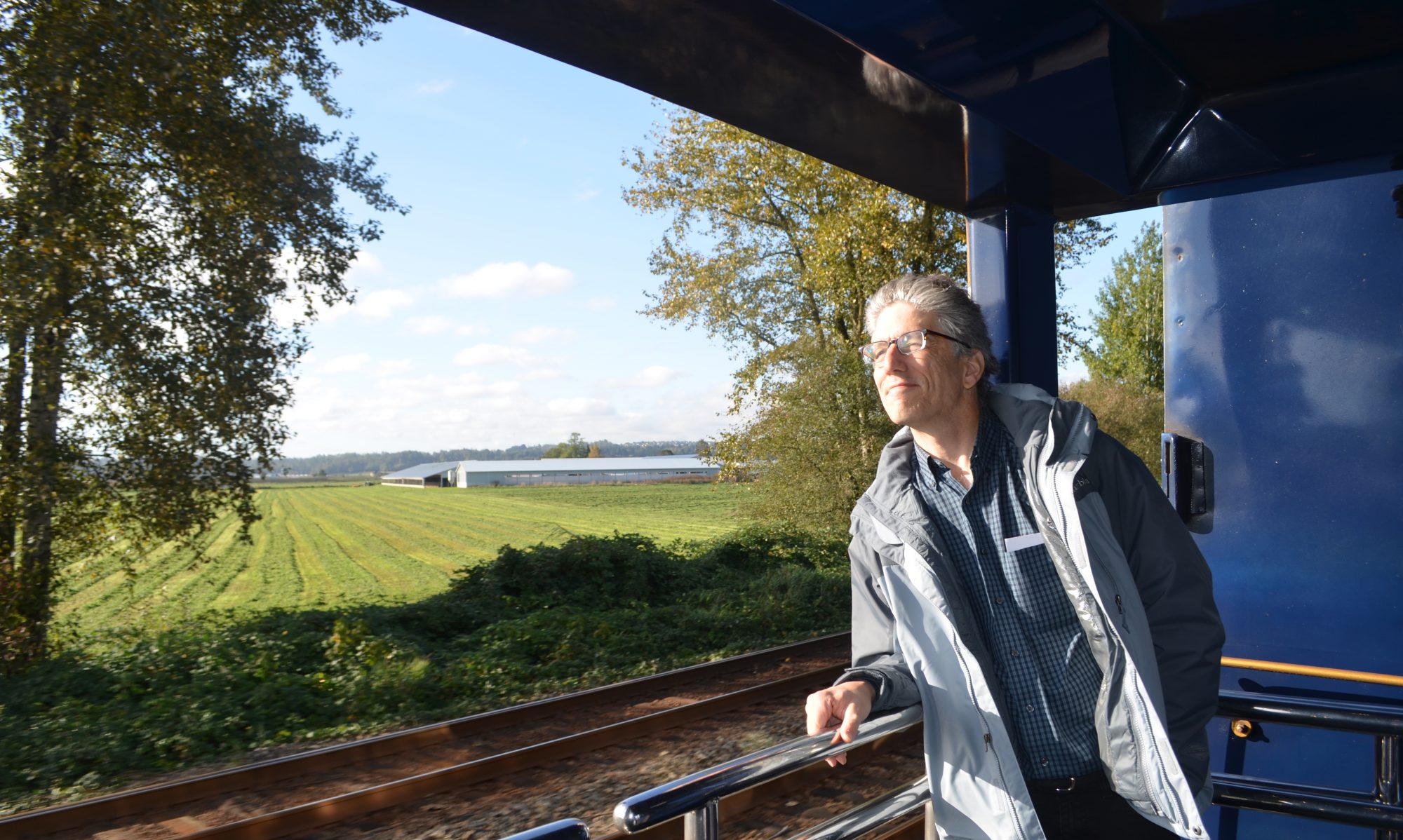David Volk and the Temple of …Damn, That’s Big!
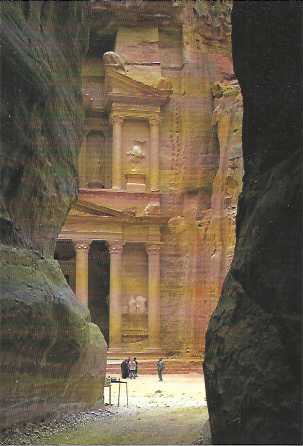
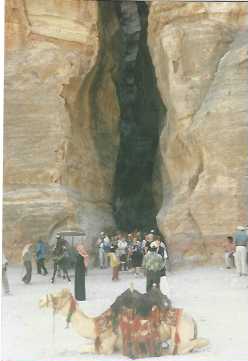
He chose…. poorly.”
–The guardian of the Holy Grail in “Indiana Jones and the Last Crusade.”
When you finally come in from out of the cold, your edge is the first thing to go.
After months on the road, I had developed street sense that protected me no matter where I went. I knew where I could go safely and where I couldn’t, what looked liked dodgy and what didn’t, and, most importantly, whom I should trust and whom I shouldn’t. As soon as I left for Petra, I realized I’d lost those street smarts. As a result, a series of disturbing thoughts flitted through my mind as I sped from Amman, Jordan to Petra early in the night before the start of the Jordanian Sabbath.
“I have no idea where the hell I’m going” was my first thought, quickly followed by, “It’s so dark, I wouldn’t even be able to find my way if I did know where I was.” Both thoughts were relatively harmless — until they were followed by the far more sinister, “This man could steal all my money and throw my body down a roadside embankment and no one would be able to find me because no one knows I’m here.”
It didn’t help that my driver remained silent through most of the ride.
Yes, there’s nothing like spending two hours racing across the desert in the back of a taxi when it’s pitch black, you have no idea if you’re headed in the right direction, and your driver isn’t going out of his way to be friendly. He wasn’t being menacing, either. Nor was he required to be hospitable, but his stone-faced stoicism not only made taciturn New England farmers seem like gossips, it also lent a sinister and frightening air to the evening.
I had only myself to blame. I’d left too late in the afternoon; I had waited for the bus to Jordan at the wrong location and then had to catch a taxi to the border. By the time I passed through the checkpoint and caught another cab to Amman, less than a half-hour ride away, it was dark, all of the businesses in town were shut tighter than burped Tupperware, there were no hotels in evidence and I had no idea where to spend the night or what to do.
Fortunately, my cab driver interceded. He just happened to have a brother who would be willing to drive me to Petra that evening. (It never ceased to amaze me how many relatives the taxi drivers I met during the trip had, and how most of the relatives happened to own hotels, restaurants or other services tourists find useful. What was even more amazing was the apparent lack of familial resemblance). Although the cabby’s brother didn’t even know he was being volunteered yet, he was sure his sibling would be happy to take me on a four-hour trip across the desert.
For a price, of course. Around $45 to be exact, which was about $43 more than the tourist buses charged. Highway robbery, yes, but I didn’t have much bargaining power. I didn’t even have 30 dinar to my name or a place to stay, but he promised his brother would accept Israeli money.
Now all he had to do was convince his brother.
The driver never told me this, of course, but when we got to his brother’s house he told me to stay in the taxi and wait until he came back. I think there may have also been some screaming a few minutes after he entered his brother’s house. When the brother finally appeared, he looked none-too-thrilled to see me, but his spirits lifted substantially when I gave him money. So, we rode off into the darkness to a hotel, which I wasn’t sure even had vacancies, but which I knew showed “Indiana Jones and the Last Crusade” every night.
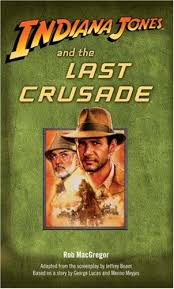
Before I go further, I’d like to say a few words about lost cities, regardless of whether they’re in Jordan, as is the case with Petra, or Africa or South America. As I see it, it’s the height of arrogance to call a city “lost,” especially if somebody lives there. The city hasn’t gone anywhere just because people of a given generation in another country don’t know how to find it. I mean, cities don’t just wake up on the wrong side of town one day and decide to move to Arizona for the cure, retire to Florida or finally rent a Winnebago and go on that trip they’ve been delaying for so many years. They are where they are regardless of whether Rand McNally knows where to put them or not. After all, if the sole criteria for a city being lost is the inability of a large number of people being able to find it on a map, then I could make a pretty good argument for including Cleveland because I am sure there are millions of Americans who wouldn’t be able to locate it,, much less accurately explain where baseball’s Indians play. And many of them live in Ohio.
Such was the case with Petra. The city dates back to 700 BC when it was the capital of a tribe of pre-Roman Arabs, the Nabateans. Because the city was located at the crossroads of numerous ancient trading routes, the tribe made its living off of the tolls it charged travelers. Seeing they had so much free time on their hands because they lived in the desert and couldn’t grow crops or listen to country music bemoaning the sad fate of the Arabian farmer, they took to whittling stupendously large, highly ornate buildings out of the face of the rosy sandstone rock formations in the town where they lived. One building in particular, the Treasury, still stands–more than 130 feet tall. Interestingly, the Treasury wasn’t where the Nabateans kept their currency, it was where they kept their dead. I’m not sure if this provided the basis for their monetary system or not, but it still makes me glad I grew up in a country that relied on the gold standard.
The city fell to the Romans around 160. It fell from grace 200 years later when an earthquake in the area caused a shift in trade routes. An additional earthquake in 747 turned much of the city into rubble.
That doesn’t mean people stopped living there, though. The city was ruled by the Byzantine Empire and later, the Arabs, for several centuries before those fun-loving people who brought you the Crusades tried to turn it into a fortress. The city fell into such precipitous decline when the effort didn’t take that it was dropped from the Rand McNally Road Atlas and no one from the outside world could find the city thereafter.
Bedouins guarded Petra and its treasures for the next 700 years, and I’m relatively sure they knew where they were. In fact, I’d venture to say that the Bedouins didn’t start having difficulty finding their way home when the rest of the world began calling Petra lost. In fact, the Bedouins were the ones who led a man claiming to be a Christian pilgrim into the city in 1812. That pilgrim was Swiss explorer Johann Burckhardt, who then whipped out his handy dandy drawing pad and began sketching the city. He slunk away when he was caught, but it was too late. Presto, change-o, what once was lost now was found — even though the town’s guardians knew where Petra had been all along, suddenly, the rest of the world declared that the city was no longer lost. It had merely been misplaced.
As far as I was concerned, the city was still lost when I got into the cab because I had no idea where I was or what direction I was supposed to travel in. As we roared down the King’s Highway and I looked out at the lonely, eerily lit moonscape of rock formations and sand dunes, I couldn’t help thinking about the sorry situation I was in. For all I knew the cabby could have been an ax murderer who was taking me into the desert to kill me, and there wasn’t much I could do to stop it because I was lost and the only protection I had was my Swiss Army Knife.
It was about this time I realized why I hadn’t grown up hearing much about Swiss military victories. Sure, the gadgets are handy for opening cans, slicing cheese and removing corks from wine bottles in a pinch at a picnic, but they didn’t seem particularly useful weapons against say, hand grenades, bazookas or airborne bombing runs.
I can just see it now, the invading enemy air force has swept in on a bombing run, decimating almost all of the troops, but the bomb that could have done the most damage to the troops doesn’t detonate. As the surviving soldiers stand around, scratching their heads trying to figure out what to do, one of them has a bright idea.
“I know, Claude, let’s pull out our Swiss Army Knives(tm) and open it up. I’ll use the can opener, you use the corkscrew and Eric will use those badass scissors.”
If only the government of Switzerland had splurged and bought guns, the world might be a different place.
And Claude’s death would not have been in vain.
The driver brought me back to reality by pointing and calling my attention to the tanker truck ahead of us.
“It’s from Iraq,” he said.
His comment surprised me not only because it was one of the few things he said the entire drive, but also because he was nonchalantly pointing out a violation of the United Nations embargo on all shipments from Iraq as if the infraction were an everyday occurrence. Judging from the number of tanker trucks on the highway, it probably was. In fact, a dozen Iraqi oil vehicles passed us before we reached Petra.
The only other time he spoke was when he criticized my lodging choice. When we neared the highway turnoff I told him I wanted to stay at the Mussa Springs Hotel. I can’t say I was surprised when he told me it was a terrible place, he knew of a better one (owned by another cousin, no doubt) and he insisted on taking me there. We battled to a draw. To humor him I agreed to consider his recommendation as long as he would take me to my choice if I didn’t like it. His suggestion was nice, the owners friendly and it was closer to Petra. It was also twice the price of the place in my guidebook, but I would have had a private room not a bed in dorm-style accommodations. I’m sure the six extra dollars wouldn’t have broken my budget, but I didn’t see the point. Besides, the other hotel showed “Indiana Jones and the Last Crusade” every night, his place didn’t.
Since the movie had inspired the trip, I wasn’t about to miss it. I had never heard of Petra before I came to Ketura, but once I got there I heard people saying great things about it. Of course, these were the same people who waxed poetic about hiking in the desert and that never motivated me to go walking in the rocks. No, what clinched it was someone telling me the old city was the place where George Lucas filmed the last sequence in “The Last Crusade.” You know the one, where Jones, Sean Connery and a cast of a thousand Nazis find the Holy Grail. Before they run into the building housing the Grail, they ride through a narrow passageway between rock formations. At the other end of the formations are huge buildings that look like they’ve been carved out of the rock itself. Before Ketura, I’d just assumed the scene had been filmed on a Hollywood studio lot and the scenery had been dreamed up by an amazing set designer. Once a few volunteers convinced me otherwise, I wanted to see the landmark and watch the film again. I didn’t know if the cabby had seen the movie and I didn’t care. Even if he had I wasn’t about to explain my reasoning to him.
So, we drove back to Mussa Springs, cabby grumbling all the way.
Fortunately, Petra was worth all of the grief I had gone through to get there….
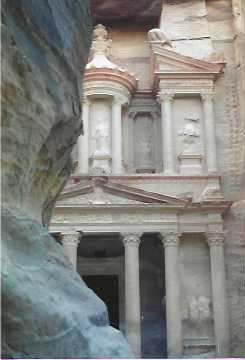
There’s a joke in Israel that Jordan has only one tourist attraction, and Petra is it. If that’s the case, the country either got lucky or chose well. As my relatives would put it, “other countries should do so poorly.”
As soon as I entered the long, brownish-pink siq leading into the city. I could see why UNESCO dubbed it a World Heritage site. The sheer scale of the place boggles the mind. The rock formations that make up either side of the natural alleyway are up to 597 feet tall and block out sunlight through much of the day, leaving large sections in shadow. Wending my way through a winding path that was only about 10 feet wide in many places made me feel like a lone grain of rice working its way through the esophagus of a giant only seeing my destination in the distance shining with sunlight mere moments before being spit into the belly of the beast. In this case, though, the heart of the monster’s mid-section was a rose-colored, highly ornate, columned building 200 feet tall and 300 feet wide by 300 feet long. It hadn’t so much been carved out of the rock as sculpted. If Michelangelo had been a contractor, this is what he would have built. Looking at the columns and the detail work at the top of the building made me once again realize ancient civilizations weren’t quite as backward as I thought. Given electricity and the right technology, any group of people who could do this without the aid of cranes, jackhammers and other modern methods probably could have come up with a much better computer operating system than Microsoft DOS…..
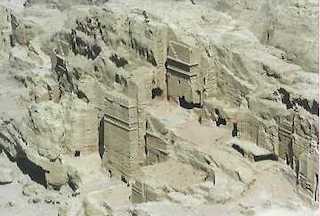
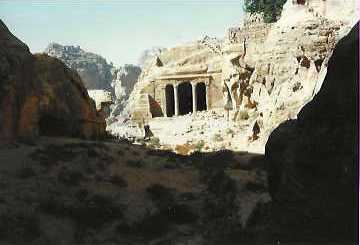
As striking as the Treasury is, there’s something even more amazing about Petra: There are more buildings just like it. They aren’t as tall or spectacular and many aren’t as well preserved, but they are all carved out of the rock face and they stretch far into the distance. Just beyond the 3,000-seat Roman Theater, for example, there are royal tombs lining both sides of the street. There’s the Royal Tomb, the Urn Tomb (which was eventually turned into a Byzantine church 400 years after it was built), the Corinthian Tomb, the Palace Tomb and the Tomb of Sextus Florentus. The concentration of buildings thinned as the distance from the Treasury increased, but it was easy to see
places carved out of rock in the distant hills.
As geological sites go, Petra is extremely expensive (around $28 for a one day pass, $35 for two), but it’s worth it. For now, at least. But many of the locals have been doing their best to destroy it in the name of commerce. As with most ancient sites, the tombs, storerooms and temples carved into the hills and cliffs in the 3rd century BC were looted long ago and are now disappearing as hawkers go in and chisel away the rosy-colored stone on the buildings so they can make a buck, selling to tourists.
As with most cities, there’s more to Petra than its central business district (or what I call “tomb town”). Because the buildings and historic sites in the far off distance are easily a day hike away, everyone I spoke to told me to buy a two-day pass. I bought a one-day pass and continued to second-guess my decision until I hiked to the High Place, an area for sacrifices with a view of all of Petra. I was told the area with two sacrificial altars, gutters for draining the blood and rock-face carved bleachers where the assembled crowds could view ritual slaughters was a moderate 30-minute hike from the Roman Theater. It took me an hour — and left me winded and sweating like a stuck pig who has spent the last five miles trying to outrun a butcher chasing after it in a car.
I knew I had had enough.
The grief that befell me before I left for Petra in the morning and the additional hassles I had when I returned confirmed the diagnosis.
It all started when I tried to exchange traveler’s cheques. The people at Mussa Springs were happy to do it.
Again, for a price. This time the commission rate was $ 7.50. In a way, the high rate made sense. The lodgings were, after all, located close to the King’s Highway and highway robbery on such a royal road shouldn’t come cheap. Since I either had to pay the commission or have no money, I pulled a well-used American Express Traveler’s Cheque out of my money belt, slapped it on the counter and asked for a pen to sign it.
Once I signed it, the clerk wouldn’t cash it because it was wrinkled and there was a small tear at the bottom. I was so irritated he hadn’t told me he before I signed it that I yelled at him. He’d had plenty of time to say it was unacceptable before I signed it because he saw it sitting on the counter while I was looking for a pen. Instead, he waited until I had rendered it useless because I couldn’t cash it anywhere else after signing and dating it.
That’s when I realized a dope slap isn’t good enough for some people. Some need to run through the forest and hit every tree.
All this happened as the driver was preparing to take the 7 a.m. bus to Petra and there were three women behind me in line trying to get on it. Since I knew there was an 8 a.m. bus, I told the clerk to let the women get on the bus and tell the driver not to wait. This confused the driver, however, because the clerk said something to him and nothing happened. I had to repeat the request several times before he finally left. I guess he must have understood what was going on, realized a dumb American was going to throw a tantrum and he wanted to be there to see the sparks fly. After much asking to see supervisors I was finally allowed to cash my check.
Again, for a price. This time the commission rate was $ 7.50. In a way, the high rate made sense. The lodgings were, after all, located close to the King’s Highway and highway robbery on such a royal road shouldn’t come cheap. Since I either had to pay the commission or have no money, I pulled a well-used American Express Traveler’s Cheque out of my money belt, slapped it on the counter and asked for a pen to sign it.
Once I signed it, the clerk wouldn’t cash it because it was wrinkled and there was a small tear at the bottom. I was so irritated he hadn’t told me he before I signed it that I yelled at him. He’d had plenty of time to say it was unacceptable before I signed it because he saw it sitting on the counter while I was looking for a pen. Instead, he waited until I had rendered it useless because I couldn’t cash it anywhere else after signing and dating it.
That’s when I realized a dope slap isn’t good enough for some people. Some need to run through the forest and hit every tree.
All this happened as the driver was preparing to take the 7 a.m. bus to Petra and there were three women behind me in line trying to get on it. Since I knew there was an 8 a.m. bus, I told the clerk to let the women get on the bus and tell the driver not to wait. This confused the driver, however, because the clerk said something to him and nothing happened. I had to repeat the request several times before he finally left. I guess he must have understood what was going on, realized a dumb American was going to throw a tantrum and he wanted to be there to see the sparks fly. After much asking to see supervisors I was finally allowed to cash my check.
I suppose I shouldn’t be surprised that the 8 a.m. bus didn’t show. The owner eventually called a friend with a pickup truck to take me the three or so miles down the hill to Petra.
I was so tired from the heat and effort of getting anywhere that I caught a cab back to my hotel at 3 p.m. for an afternoon nap. I planned to go back down to Petra around 7, though, because I heard sunsets there were amazing. Sadly, I experienced more grief on my walk back.
This time, the grief came courtesy of a pair of pre-pubescent boys. Since I knew I faced a long, lonely walk in both directions, I decided to bring my tape recorder with me so I could listen to a tape of kibbutz life I had recorded for a friend. That way I would know if the sounds were intelligible and add commentary explaining what the sounds were, if necessary. When the two boys playing on the roadside saw me and heard the tape recorder, they ran and got their horses. Then they rode up alongside me to see if I would sell it. Although I said no, they would not be refused and kept trying to wear me down, I guess. They even offered money and kept raising the ante. At one point, the bidding reached 20 Dinar and a horse. I think it was a horse. For all I know it could have been a mule.
I can just see myself at the Jordanian border trying to convince customs the mule was mine, free and clear. Somehow I didn’t think any border agent worth his salt would believe me if I said, “No, honest, officer, I didn’t steal it. Two kids sold it to me for a tape recorder.” Truth be told, however, I didn’t think a horse was so practical a possession for a backpacker getting ready to go home. The animal would have been great for hauling my backpack, but he wouldn’t be very good at recording sounds and I was relatively certain I wouldn’t be able to stow him under the seat in front of me or in the airplane’s overhead compartment. The bidding may have been amusing for the first five minutes, but when I realized I wasn’t going to be able to shake them I turned around and went back to the hotel to watch “Indiana Jones and the Last Crusade.”
As it turns out, Petra’s appearance in the movie is remarkably short compared to the hype it had generated among travelers. In fact, I wouldn’t be surprised if its appearance lasted three minutes total.
I could have spent another day in Jordan, but I was tired of the grief, so I returned to the kibbutz the next morning and met a hassle at the border. Getting out of Jordan was easy. When the guard found out I had only spent one full day in Jordan, he good-humoredly chastised me and told me Israel was more expensive. (It’s a toss-up, actually). When I responded with my typical loud laugh — an obnoxious, full-bodied belly laugh that has gotten me thrown out of newsrooms and shushed in movie theatres — he told me I had a beautiful laugh. He also looked at my passport and the papers of Terri, a Canadian woman I’d met on the bus, then asked the meaning of our names. She was shocked by the question because she didn’t expect it or understand what it meant. Without missing a beat I told him my name meant “beloved” (which it does) and hers meant “Lover of trees.”
And we all had a good laugh and he sent us on our way.
Crossing back into Israel proved more difficult because I set off the metal detector at the checkpoint. Before I passed through the second time I put all my change in a bucket. The third time I gave them my belt and kibbutz room key. The final time I had to take off my hiking boots just to make it through the metal detector.
And so it was that I re-entered the Holy Land without my shoes.
